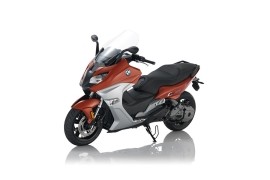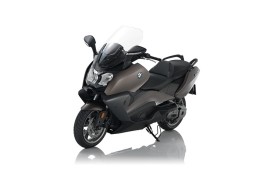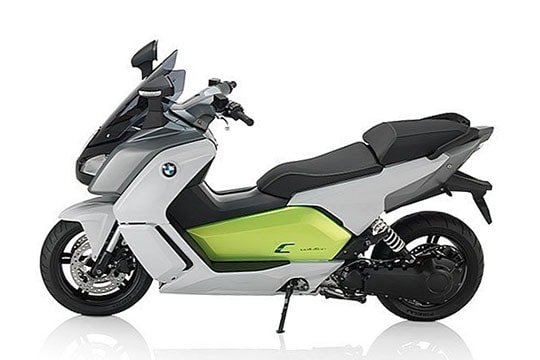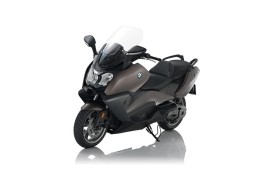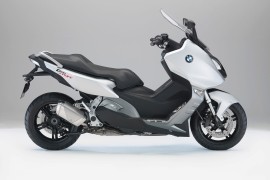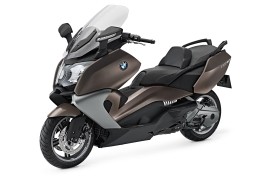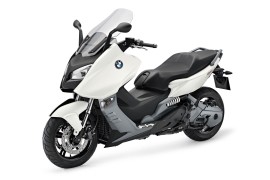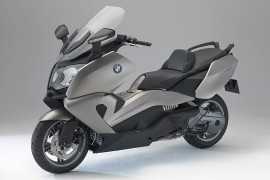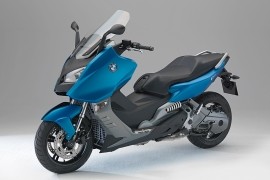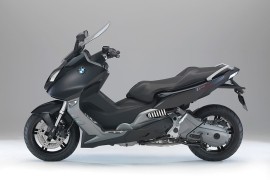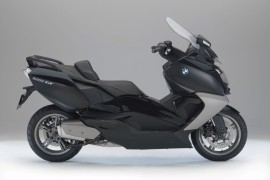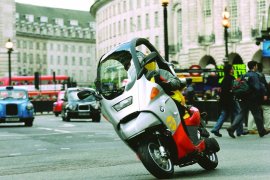BMW C Models/Series Timeline, Specifications & Photos
First production year: 2000
The BMW C 600 Sport, alongside the C 650 GT, was a maxi-scooter manufactured by BMW Motorrad since 2012 at BMW's plant in Spandau, Germany. It was BMW's first scooter since the C1, which was manufactured by Bertone.
The line was presented at the EICMA Show in late 2010, and production started in December 2011. They were available in Europe in the spring of 2012 and in the fall of 2012 in the US for the 2013 model year.
In 2015, the German motorcycle manufacturer released the BMW C 600 Sport, a sportier version than the GT version. It was in the fourth consecutive production year and came with the same specifications as the previous one without any changes.
In the aesthetic department, the scooter had standard fittings, like a full fairing, two headlights, a tall windscreen, a one-piece dual seat with passenger grab handles, a horizontally-mounted shock absorber, a single-sided swingarm, and five-spoke blacked-out wheels.
The bike was made around an aluminum frame with a 40 mm upside-down fork on the front that provided 115 mm wheel travel and a single-sided swingarm with a shock absorber on the rear, offering 115 mm of travel and excellent performance and handling.
A for power, the 2015 BMW C 600 Sport had its soul brought to life by a 647cc four-stroke liquid-cooled two-cylinder engine mounted at its core, delivering an output power of 60 hp with a peak force at 7,500 rpm and 66 Nm (49 lb-ft) torque at 6,000 rpm.
In 2015, the German motorcycle manufacturer released the BMW C 650 GT, a maxi-scooter that debuted in 2012 alongside the C 600 Sport. Although the scooters had different designations, they were powered by the same 647cc engine.
The scooter was first presented in late 2010 at the EICMA Show alongside the BMW R 600 Sport. The production started in December 2011 and was available for purchase in 2012 in Europe and in 2012 for the 2013 model year in the USA.
The 2015 model came in the same shape and form as the previous one, delivering the same technical, visual, and performance specifications. No updates or modifications were present on the 2015 model.
The model's visual department was characterized by standard features, such as a full fairing, two headlights, a tall windscreen, a one-piece dual seat with passenger grab handles, a horizontally-mounted shock absorber, a single-sided swingarm, and five-spoke blacked-out wheels.
In the performance department, the 2015 BMW C 650 GT had its soul brought to life by a 647cc four-stroke liquid-cooled two-cylinder engine mounted at its core, boasting 60 hp with maximum strength at 7,500 rpm and 66 Nm (49 lb-ft) torque at 6,000 rpm.
The machine was manufactured around a steel tube frame with a die-cast aluminum unit, housing the suspension system comprised of a 40 mm upside-down fork with 115 mm of travel on the front and a single-sided swingarm on the rear with 115 mm of travel, offering an excellent and plush riding experience.
In 2014, the German motorcycle maker introduced the BMW C EVOLUTION, an electric scooter that marked the start of a new chapter for BMW Motorrad in the urban mobility segment.
The two gasoline-powered scooters, C 600 Sport and C 650 GT have already combined the excellent ride qualities of a motorcycle with the agility and comfort of a scooter. The C EVOLUTION took everything further by combining riding fun and dynamism with zero-emissions performance for a new two-wheel experience.
One notable feature of the C EVOLUTION was the energy regeneration never seen on a single-track vehicle. The regeneration was made automatically when coasting with the throttle closed and when the brakes were used.
The electric scooter was available with Torque Control Assist (TCA), similar to the Automatic Stability Control (ASC) found on BMW combustion motorcycles. The system limits the torque depending on the slip at the rear wheel.
The 2014 BMW C EVOLUTION was powered by a drive train swing arm with a liquid-cooled alternator that delivered an output power of 48 hp at 4,850 rpm and 72 Nm (53 lb-ft) torque at 4,500 rpm.
Some other notable features included four riding modes, Road, Eco Pro, Sail, and Dynamic, a high-voltage battery with air cooling, a powerful ABS braking system, a large TFT color display, an LED daytime running light and side light, and reversing aid for easy maneuvering.
The BMW C 650 GT and the C 600 Sport were maxi-scooters produced by BMW Motorrad since 2012 at BMW's plant in Spandau, Germany. It was BMW's first scooter since the C1, which was manufactured by Bertone.
In 2014, the German motorcycle maker launched the BMW C 650 GT, a more comfortable maxi-scooter than the Sport version. It was in the third consecutive production year and packed the same technical, visual, and performance specifications as the previous one without any changes.
The scooter's visual department was characterized by standard features, such as a single, large headlight, a large windscreen, the body covered with fairings, a two-up seat with a rider backrest and passenger grab rails, a single-sided swingarm, and five-spoke alloy wheels.
It was built around a steel tube frame with a die-cast aluminum unit. For suspension, it packed a 40 mm upside-down fork with 115 mm of travel on the front and a single-sided swingarm on the rear with 115 mm of travel, offering an excellent and plush riding experience.
As for the power figures, the 2014 BMW C 650 GT had its soul brought to life by a 647cc four-stroke two-cylinder liquid-cooled engine mounted underneath its fairings, delivering an output power of 60 hp with a peak force at 7,500 rpm and 66 Nm (49 lb-ft) torque at 6,000 rpm.
The BMW C 600 Sport was a maxi-scooter made by BMW in 2012. The bike was produced at BMW's plant in Spandau, Germany, and was their first scooter after the BMW C1 manufactured by Bertone.
The scooter was first presented in late 2010 at the EICMA Show alongside the BMW R 650 GT. The production started in December 2011 and was available for purchase in 2012 in Europe and in 2012 for the 2013 model year in the USA.
In 2014, the German motorcycle maker released the BMW C 600 Sport, a maxi-scooter, in the third consecutive production year. Compared to the GT version, the Sport model had a sportier appearance and several aesthetic differences.
The 2014 model came in the same shape and form as previous ones, offering the same technical, visual, and performance specifications without any significant changes. Despite their designation, both models were set in motion by a 647cc engine.
Aesthetically, the scooter was characterized by standard features, such as a full fairing, two headlights, a tall windscreen, a one-piece dual seat with passenger grab handles, a horizontally-mounted shock absorber, a single-sided swingarm, and five-spoke blacked-out wheels.
As for power, the 2014 BMW C 600 Sport was set in motion by a 647cc four-stroke liquid-cooled two-cylinder engine mounted at its core, boasting 60 hp with a peak force at 7,500 rpm and 66 Nm (49 lb-ft) torque at 6,000 rpm.
In 2013, the German motorcycle manufacturer released the BMW C 650 GT, a 650cc scooter, in its second production year. It came in the same shape and form as the previous one without any significant changes.
The BMW C 650 GT and the C 600 Sport were maxi-scooters manufactured by BMW Motorrad since 2012. It was BMW's first scooter since the C1, which was manufactured by Bertone.
Both scooters were first introduced at the EICMA Show in late 2010 and were the only models in the line. The production started in 2011 and was released in Europe in 2012 and in the USA in 2012 for the 2013 model year. Both models were powered by a 647cc engine, despite their designations.
In the performance department, the 2013 BMW C 650 GT had its heartbeat set by a 647cc four-stroke two-cylinder liquid-cooled engine mounted underneath its fairings, delivering an output power of 60 hp with a peak force at 7,500 rpm and 66 Nm (49 lb-ft) torque at 6,000 rpm.
Aesthetically, the scooter had standard fittings, like a single, large headlight, a large windscreen, all the body covered with fairings, a two-up seat with a rider backrest and passenger grab rails, a single-sided swingarm, and five-spoke alloy wheels.
It was built around a steel tube frame with a die-cast aluminum unit. For suspension, it packed a 40 mm upside-down fork with 115 mm of travel on the front and a single-sided swingarm on the rear with 115 mm of travel, offering an excellent and plush riding experience.
In 2013, the German motorcycle manufacturer released the BMW C 600 Sport, a scooter in its second production year. Compared to the GT version, the Sport model, as its name suggests, had a sportier appearance with several visual differences.
In the visual department, the scooter had a full fairing, two headlights, a tall windscreen, a one-piece dual seat with passenger grab handles, a horizontally-mounted shock absorber, a single-sided swingarm, and five-spoke blacked-out wheels.
Both the C600 Sport and C600GT models were powered by a 647cc parallel twin engine. Their production started in 2011 at BMW's Spandau plant In Germany and was available from 2012 in the European market and in 2012 for the 2013 model year in the American market.
In the power department, the 2013 BMW C 600 Sport had installed a 647cc four-stroke liquid-cooled two-cylinder engine at its core, boasting 60 hp with a peak force at 7,500 rpm and 66 Nm (49 lb-ft) torque at 6,000 rpm.
The bike was produced around an aluminum frame with a 40 mm upside-down fork on the front that provided 115 mm wheel travel and a single-sided swingarm with a shock absorber on the rear, offering 115 mm of travel and excellent performance and handling.
As for the braking power, the wheels were fitted with two 270 mm discs with dual-piston floating calipers on the front wheel and a 270 mm rotor with a dual-piston floating caliper on the rear wheel.
The BMW C650 GT, alongside the C600 Sport, was a maxi-scooter manufactured by BMW Motorrad since 2012. It was BMW's first scooter since the C1, which was manufactured by Bertone.
The line was introduced in late 2010 at the EICMA Show. They were the only models in the line powered by a 647cc parallel-twin engine. The production began in 2011 at BMW's plant in Spandau, Germany, and was released into the market in 2012 in Europe and 2012 in the US for the 2013 model year.
In the visual department, the scooter had standard fittings, such as a single, large headlight, a large windscreen, all the body covered with fairings, a two-up seat with a rider backrest and passenger grab rails, a single-sided swingarm, and five-spoke alloy wheels.
The scooter was made around a steel tube frame with a die-cast aluminum unit. For suspension, it packed a 40 mm upside-down fork with 115 mm of travel on the front and a single-sided swingarm on the rear with 115 mm of travel, offering an excellent and plush riding experience.
As for power, the 2012 BMW C 650 GT had installed a 647cc four-stroke two-cylinder liquid-cooled engine underneath its fairings, delivering an output power of 60 hp with a peak force at 7,500 rpm and 66 Nm (49 lb-ft) torque at 6,000 rpm.
In late 2010, at the EICMA Show, the German motorcycle manufacturer introduced the BMW C 600 Sport and C 600 GT, two maxi-scooters made by BMW Motorrad. The C600 was the company's first scooter since the BMW C1 manufactured by Bertone.
Both the C 600 Sport and C 600 GT models were powered by a 647cc parallel twin engine and started production at BMW's Spandau plant in 2011. They were available in 2012 in the European market and in 2012 for the 2013 model year in the American market.
In the visual department, the BMW C 600 Sport had standard fittings, such as a full fairing, a medium-sized windscreen, a one-piece dual seat with passenger grab handles, a center stand, and lightweight aluminum wheels.
The bike was made around an aluminum frame with a 40 mm upside-down fork on the front with 115 mm wheel travel and a single-sided swingarm with a shock absorber on the rear, offering optimum suspension performance and handling.
The braking power was achieved by two 270 mm discs with dual-piston floating calipers on the front wheel and a 270 mm rotor with a dual-piston floating caliper on the rear wheel, providing excellent suspension performance.
In the performance department, the 2012 BMW C 600 Sport had its heartbeat set by a 647cc four-stroke two-cylinder liquid-cooled engine that delivered an output power of 60 hp at 7,500 rpm and 66 Nm (49 lb-ft) torque at 6,000 rpm.
In late 2010, at the EICMA Show, the German motorcycle manufacturer introduced the BMW C600 Sport and C600GT, two maxi-scooters manufactured by BMW Motorrad. The C600 was the company's first scooter since the BMW C1 manufactured by Bertone.
Both the C600 and the C600GT models were powered by a 647cc parallel twin engine and started production at BMW's Spandau plant in 2011. They were available in 2012 in the European market and in 2012 for the 2013 model year in the American market.
In the aesthetic department, the BMW C600 Sport had standard features, such as a full fairing, a medium-sized windscreen, a one-piece dual seat with passenger grab handles, a center stand, and lightweight aluminum wheels.
The bike was built on an aluminum frame with a 40 mm upside-down fork on the front with 115 mm wheel travel and a single-sided swingarm with a shock absorber on the rear, offering optimum suspension performance and handling.
The braking power was achieved by two 270 mm discs with dual-piston floating calipers on the front wheel and a 270 mm disc with a dual-piston floating caliper on the rear wheel, providing excellent suspension performance.
As for the power figures, the 2012 BMW C600 Sport had its soul brought to life by a 647cc four-stroke two-cylinder liquid-cooled engine that delivered an output power of 60 hp at 7,500 rpm and 66 Nm (49 lb-ft) torque at 6,000 rpm.
The 2012 MY BMW C 650 GT addresses scooter fans that want a machine capable of going the extra mile. It sports a liquid-cooled, four-stroke, 647cc, two cylinder lump, mated to a continuously variable transmission (CVT), and can produce 60 horsepower and 66 Nm of torque. Also, it comes standard with an electrically adjustable high windscreen, for better protection against the elements, and a generous storage space, a dual seat with rider lumbar support, as well as pillion grab-rails, which make it excellent for extended trips. In addition, it is exceptionally safe, due to the fact it comes with BMW Motorrad ABS as standard, for when the going gets tough.
The BMW C1 was a scooter with a roof made by Bertone for the German Company, which, compared to other scooters, offered increased protection from the elements and extra safety. The rider was grasped by a car-type seat with a four-point seatbelt and a feet-forward position.
The scooter was introduced in 2000 and was available throughout the European market, but unfortunately, the sales didn't go as expected, and it was removed from production in 2002. Later, in 2009, the manufacturer introduced the C1-E electric version as a concept vehicle.
The BMW C1 scooter was available from 2000 with a 125cc engine, and from 2001, a 200cc model was added. In addition, the bike was available with four trim lines, including the Base, Family's Friend, Executive, and Williams.
The Base version was stock, the Family's Friend version packed the same features as the base model with an extra luggage attachment kit and a storage compartment in the front fairing, and the Executive model packed the same features as the Family's Friend version with an extra reading light and a phone holder. The Williams model had the features of the Executive version with a unique paint scheme.
The 2000 BMW C1 had installed at its core a 124cc four-stroke single-cylinder liquid-cooled engine with an electric injection system, boasting 15 hp at 9,259 rpm and 12 Nm (8.8 lb-ft) torque at 6,500 rpm.
